Trading.com: Analysis of Risks and Strategies for Improvement
VerifiedAdded on 2023/03/20
|12
|2883
|56
Report
AI Summary
This report analyzes the risks faced by Trading.com, a start-up offering educational seminars and mentoring services, using Robert Simons' risk exposure calculator (REC). The report identifies key risks related to growth, including employee pressure, rapid expansion, and inexperience of key employees. It also examines risks associated with organizational culture, such as lack of rewards for risk-taking, executive resistance to bad news, and high internal competition. Furthermore, the report assesses information handling risks, including transaction complexity, gaps in diagnostic performance, and a centralized decision-making system. The REC yields a score of 39, indicating a high-risk environment. The report concludes with recommendations to mitigate these risks, including slowing expansion, improving employment standards, offering higher fixed salaries, fostering a positive organizational culture, and implementing a decentralized decision-making framework. These recommendations aim to improve the overall effectiveness and sustainability of Trading.com.
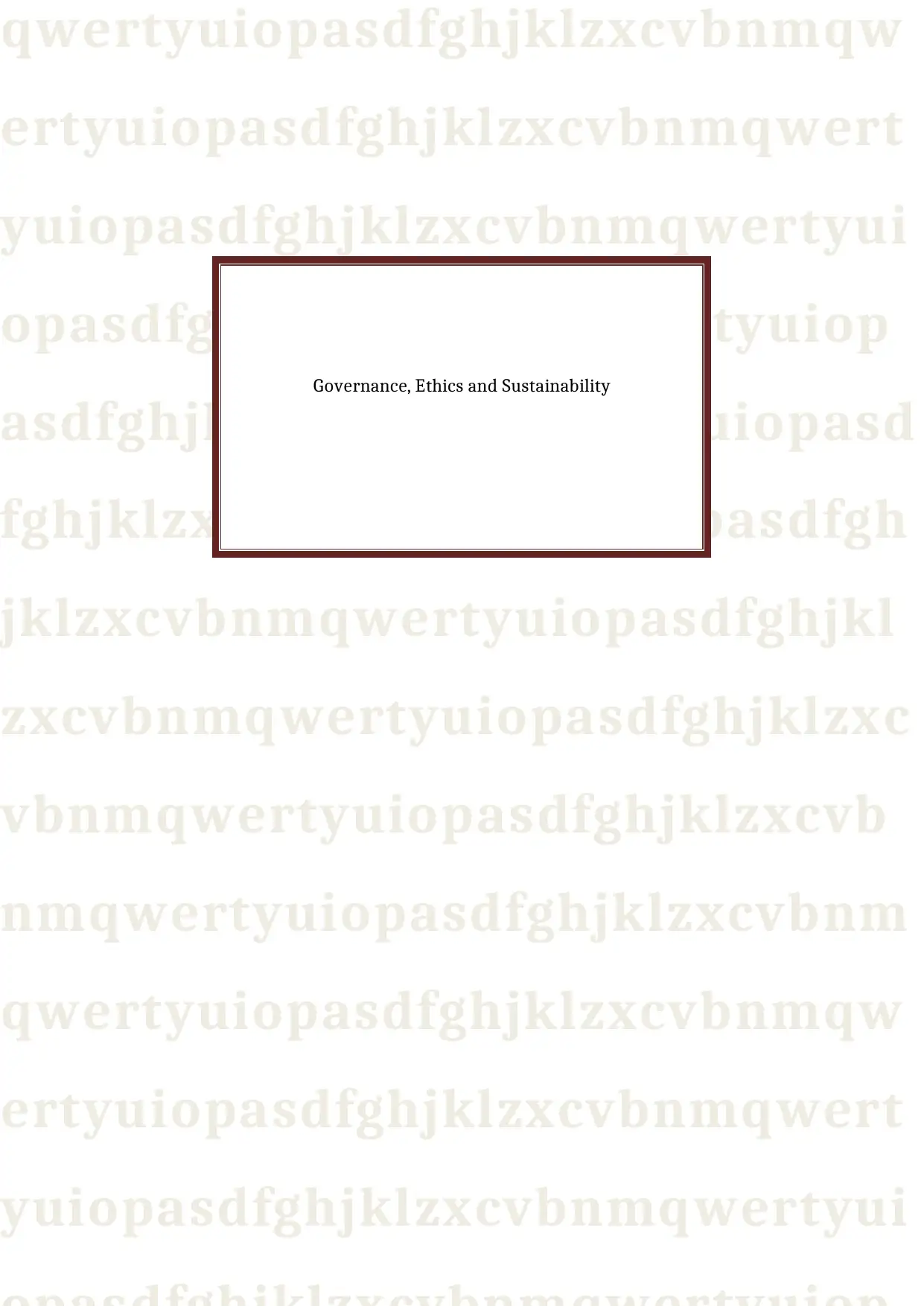
qwertyuiopasdfghjklzxcvbnmqw
ertyuiopasdfghjklzxcvbnmqwert
yuiopasdfghjklzxcvbnmqwertyui
opasdfghjklzxcvbnmqwertyuiop
asdfghjklzxcvbnmqwertyuiopasd
fghjklzxcvbnmqwertyuiopasdfgh
jklzxcvbnmqwertyuiopasdfghjkl
zxcvbnmqwertyuiopasdfghjklzxc
vbnmqwertyuiopasdfghjklzxcvb
nmqwertyuiopasdfghjklzxcvbnm
qwertyuiopasdfghjklzxcvbnmqw
ertyuiopasdfghjklzxcvbnmqwert
yuiopasdfghjklzxcvbnmqwertyui
Governance, Ethics and Sustainability
ertyuiopasdfghjklzxcvbnmqwert
yuiopasdfghjklzxcvbnmqwertyui
opasdfghjklzxcvbnmqwertyuiop
asdfghjklzxcvbnmqwertyuiopasd
fghjklzxcvbnmqwertyuiopasdfgh
jklzxcvbnmqwertyuiopasdfghjkl
zxcvbnmqwertyuiopasdfghjklzxc
vbnmqwertyuiopasdfghjklzxcvb
nmqwertyuiopasdfghjklzxcvbnm
qwertyuiopasdfghjklzxcvbnmqw
ertyuiopasdfghjklzxcvbnmqwert
yuiopasdfghjklzxcvbnmqwertyui
Governance, Ethics and Sustainability
Paraphrase This Document
Need a fresh take? Get an instant paraphrase of this document with our AI Paraphraser
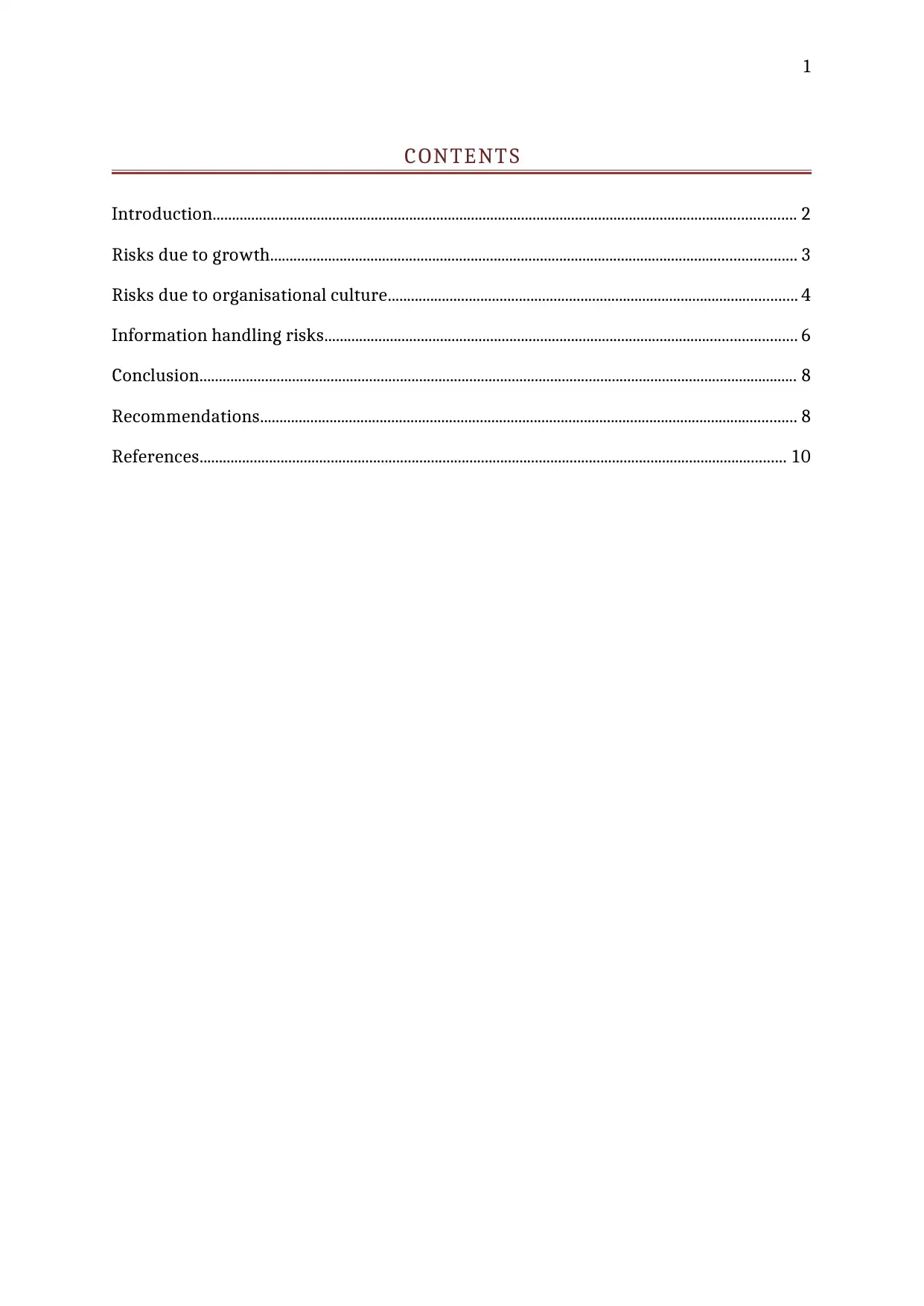
1
CONTENTS
Introduction....................................................................................................................................................... 2
Risks due to growth........................................................................................................................................ 3
Risks due to organisational culture.......................................................................................................... 4
Information handling risks.......................................................................................................................... 6
Conclusion........................................................................................................................................................... 8
Recommendations........................................................................................................................................... 8
References........................................................................................................................................................ 10
CONTENTS
Introduction....................................................................................................................................................... 2
Risks due to growth........................................................................................................................................ 3
Risks due to organisational culture.......................................................................................................... 4
Information handling risks.......................................................................................................................... 6
Conclusion........................................................................................................................................................... 8
Recommendations........................................................................................................................................... 8
References........................................................................................................................................................ 10
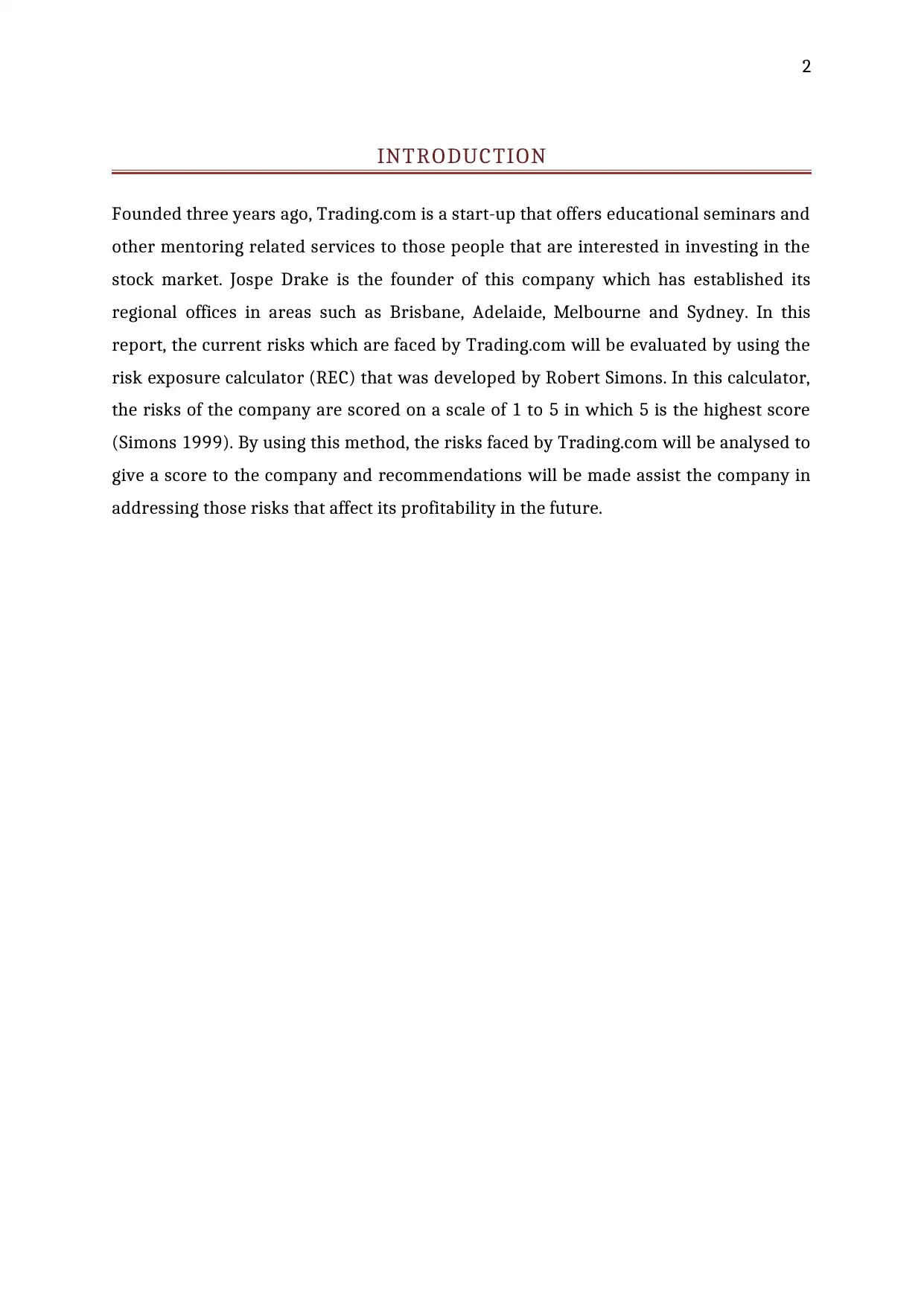
2
INTRODUCTION
Founded three years ago, Trading.com is a start-up that offers educational seminars and
other mentoring related services to those people that are interested in investing in the
stock market. Jospe Drake is the founder of this company which has established its
regional offices in areas such as Brisbane, Adelaide, Melbourne and Sydney. In this
report, the current risks which are faced by Trading.com will be evaluated by using the
risk exposure calculator (REC) that was developed by Robert Simons. In this calculator,
the risks of the company are scored on a scale of 1 to 5 in which 5 is the highest score
(Simons 1999). By using this method, the risks faced by Trading.com will be analysed to
give a score to the company and recommendations will be made assist the company in
addressing those risks that affect its profitability in the future.
INTRODUCTION
Founded three years ago, Trading.com is a start-up that offers educational seminars and
other mentoring related services to those people that are interested in investing in the
stock market. Jospe Drake is the founder of this company which has established its
regional offices in areas such as Brisbane, Adelaide, Melbourne and Sydney. In this
report, the current risks which are faced by Trading.com will be evaluated by using the
risk exposure calculator (REC) that was developed by Robert Simons. In this calculator,
the risks of the company are scored on a scale of 1 to 5 in which 5 is the highest score
(Simons 1999). By using this method, the risks faced by Trading.com will be analysed to
give a score to the company and recommendations will be made assist the company in
addressing those risks that affect its profitability in the future.
⊘ This is a preview!⊘
Do you want full access?
Subscribe today to unlock all pages.

Trusted by 1+ million students worldwide
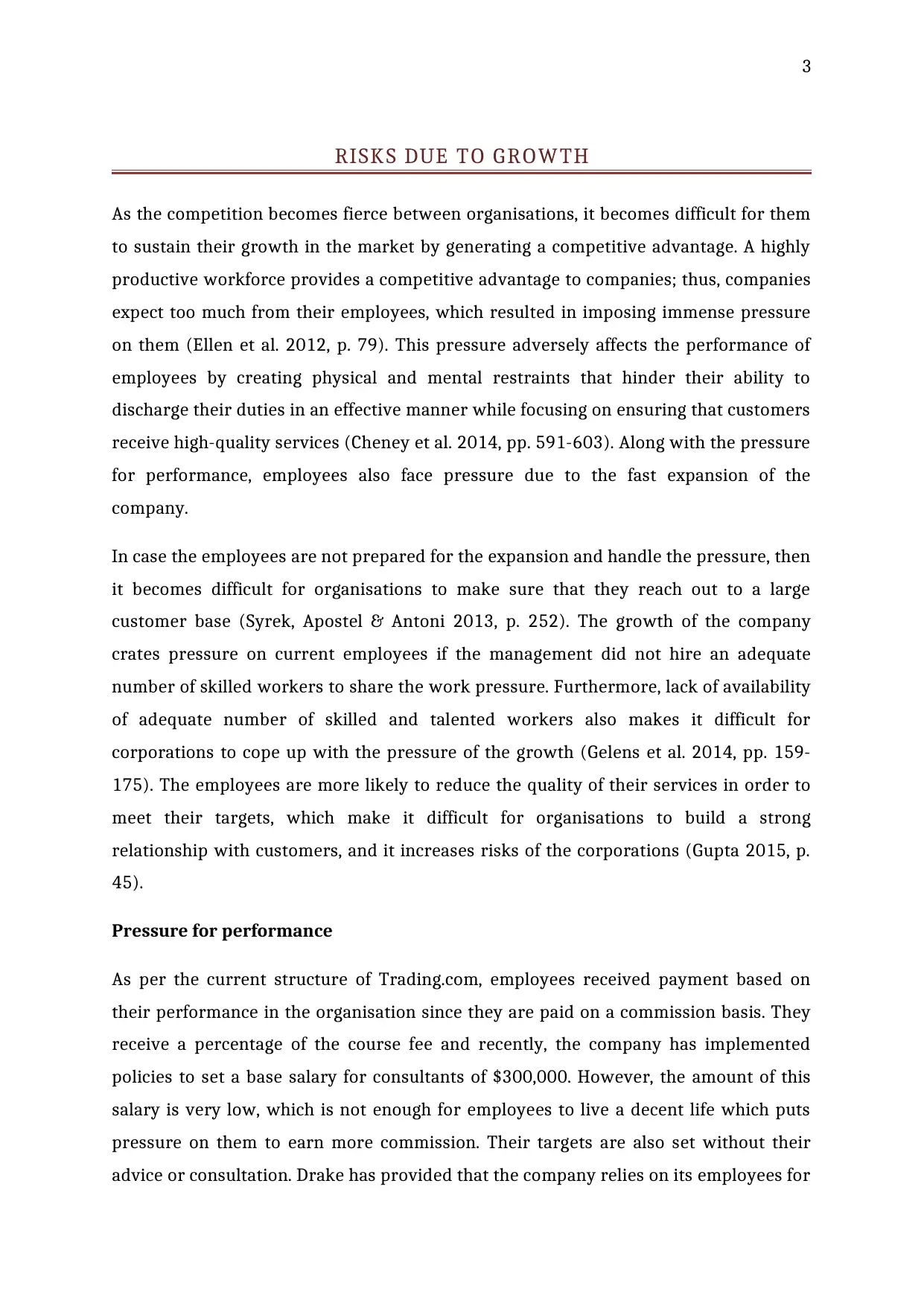
3
RISKS DUE TO GROWTH
As the competition becomes fierce between organisations, it becomes difficult for them
to sustain their growth in the market by generating a competitive advantage. A highly
productive workforce provides a competitive advantage to companies; thus, companies
expect too much from their employees, which resulted in imposing immense pressure
on them (Ellen et al. 2012, p. 79). This pressure adversely affects the performance of
employees by creating physical and mental restraints that hinder their ability to
discharge their duties in an effective manner while focusing on ensuring that customers
receive high-quality services (Cheney et al. 2014, pp. 591-603). Along with the pressure
for performance, employees also face pressure due to the fast expansion of the
company.
In case the employees are not prepared for the expansion and handle the pressure, then
it becomes difficult for organisations to make sure that they reach out to a large
customer base (Syrek, Apostel & Antoni 2013, p. 252). The growth of the company
crates pressure on current employees if the management did not hire an adequate
number of skilled workers to share the work pressure. Furthermore, lack of availability
of adequate number of skilled and talented workers also makes it difficult for
corporations to cope up with the pressure of the growth (Gelens et al. 2014, pp. 159-
175). The employees are more likely to reduce the quality of their services in order to
meet their targets, which make it difficult for organisations to build a strong
relationship with customers, and it increases risks of the corporations (Gupta 2015, p.
45).
Pressure for performance
As per the current structure of Trading.com, employees received payment based on
their performance in the organisation since they are paid on a commission basis. They
receive a percentage of the course fee and recently, the company has implemented
policies to set a base salary for consultants of $300,000. However, the amount of this
salary is very low, which is not enough for employees to live a decent life which puts
pressure on them to earn more commission. Their targets are also set without their
advice or consultation. Drake has provided that the company relies on its employees for
RISKS DUE TO GROWTH
As the competition becomes fierce between organisations, it becomes difficult for them
to sustain their growth in the market by generating a competitive advantage. A highly
productive workforce provides a competitive advantage to companies; thus, companies
expect too much from their employees, which resulted in imposing immense pressure
on them (Ellen et al. 2012, p. 79). This pressure adversely affects the performance of
employees by creating physical and mental restraints that hinder their ability to
discharge their duties in an effective manner while focusing on ensuring that customers
receive high-quality services (Cheney et al. 2014, pp. 591-603). Along with the pressure
for performance, employees also face pressure due to the fast expansion of the
company.
In case the employees are not prepared for the expansion and handle the pressure, then
it becomes difficult for organisations to make sure that they reach out to a large
customer base (Syrek, Apostel & Antoni 2013, p. 252). The growth of the company
crates pressure on current employees if the management did not hire an adequate
number of skilled workers to share the work pressure. Furthermore, lack of availability
of adequate number of skilled and talented workers also makes it difficult for
corporations to cope up with the pressure of the growth (Gelens et al. 2014, pp. 159-
175). The employees are more likely to reduce the quality of their services in order to
meet their targets, which make it difficult for organisations to build a strong
relationship with customers, and it increases risks of the corporations (Gupta 2015, p.
45).
Pressure for performance
As per the current structure of Trading.com, employees received payment based on
their performance in the organisation since they are paid on a commission basis. They
receive a percentage of the course fee and recently, the company has implemented
policies to set a base salary for consultants of $300,000. However, the amount of this
salary is very low, which is not enough for employees to live a decent life which puts
pressure on them to earn more commission. Their targets are also set without their
advice or consultation. Drake has provided that the company relies on its employees for
Paraphrase This Document
Need a fresh take? Get an instant paraphrase of this document with our AI Paraphraser
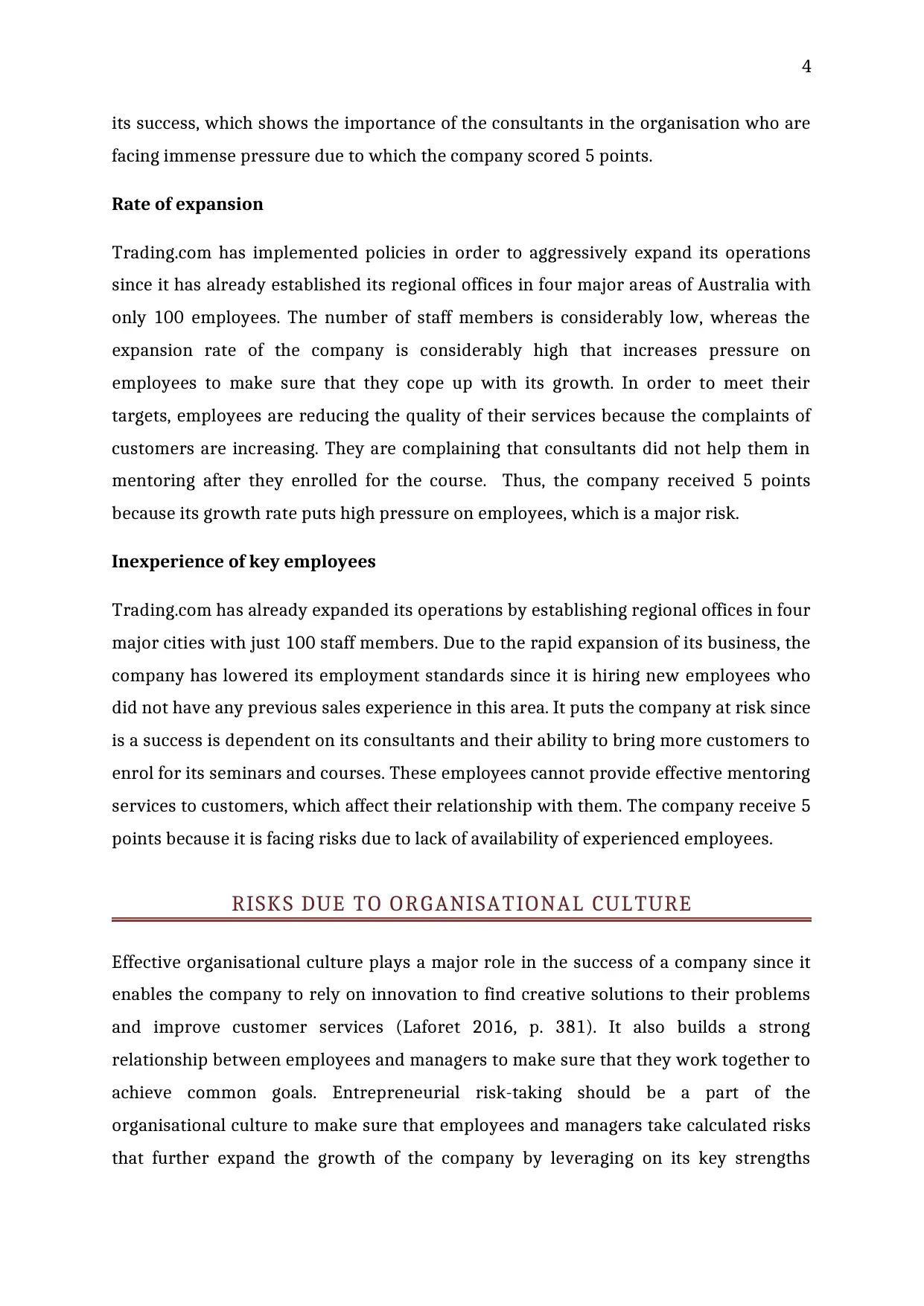
4
its success, which shows the importance of the consultants in the organisation who are
facing immense pressure due to which the company scored 5 points.
Rate of expansion
Trading.com has implemented policies in order to aggressively expand its operations
since it has already established its regional offices in four major areas of Australia with
only 100 employees. The number of staff members is considerably low, whereas the
expansion rate of the company is considerably high that increases pressure on
employees to make sure that they cope up with its growth. In order to meet their
targets, employees are reducing the quality of their services because the complaints of
customers are increasing. They are complaining that consultants did not help them in
mentoring after they enrolled for the course. Thus, the company received 5 points
because its growth rate puts high pressure on employees, which is a major risk.
Inexperience of key employees
Trading.com has already expanded its operations by establishing regional offices in four
major cities with just 100 staff members. Due to the rapid expansion of its business, the
company has lowered its employment standards since it is hiring new employees who
did not have any previous sales experience in this area. It puts the company at risk since
is a success is dependent on its consultants and their ability to bring more customers to
enrol for its seminars and courses. These employees cannot provide effective mentoring
services to customers, which affect their relationship with them. The company receive 5
points because it is facing risks due to lack of availability of experienced employees.
RISKS DUE TO ORGANISATIONAL CULTURE
Effective organisational culture plays a major role in the success of a company since it
enables the company to rely on innovation to find creative solutions to their problems
and improve customer services (Laforet 2016, p. 381). It also builds a strong
relationship between employees and managers to make sure that they work together to
achieve common goals. Entrepreneurial risk-taking should be a part of the
organisational culture to make sure that employees and managers take calculated risks
that further expand the growth of the company by leveraging on its key strengths
its success, which shows the importance of the consultants in the organisation who are
facing immense pressure due to which the company scored 5 points.
Rate of expansion
Trading.com has implemented policies in order to aggressively expand its operations
since it has already established its regional offices in four major areas of Australia with
only 100 employees. The number of staff members is considerably low, whereas the
expansion rate of the company is considerably high that increases pressure on
employees to make sure that they cope up with its growth. In order to meet their
targets, employees are reducing the quality of their services because the complaints of
customers are increasing. They are complaining that consultants did not help them in
mentoring after they enrolled for the course. Thus, the company received 5 points
because its growth rate puts high pressure on employees, which is a major risk.
Inexperience of key employees
Trading.com has already expanded its operations by establishing regional offices in four
major cities with just 100 staff members. Due to the rapid expansion of its business, the
company has lowered its employment standards since it is hiring new employees who
did not have any previous sales experience in this area. It puts the company at risk since
is a success is dependent on its consultants and their ability to bring more customers to
enrol for its seminars and courses. These employees cannot provide effective mentoring
services to customers, which affect their relationship with them. The company receive 5
points because it is facing risks due to lack of availability of experienced employees.
RISKS DUE TO ORGANISATIONAL CULTURE
Effective organisational culture plays a major role in the success of a company since it
enables the company to rely on innovation to find creative solutions to their problems
and improve customer services (Laforet 2016, p. 381). It also builds a strong
relationship between employees and managers to make sure that they work together to
achieve common goals. Entrepreneurial risk-taking should be a part of the
organisational culture to make sure that employees and managers take calculated risks
that further expand the growth of the company by leveraging on its key strengths
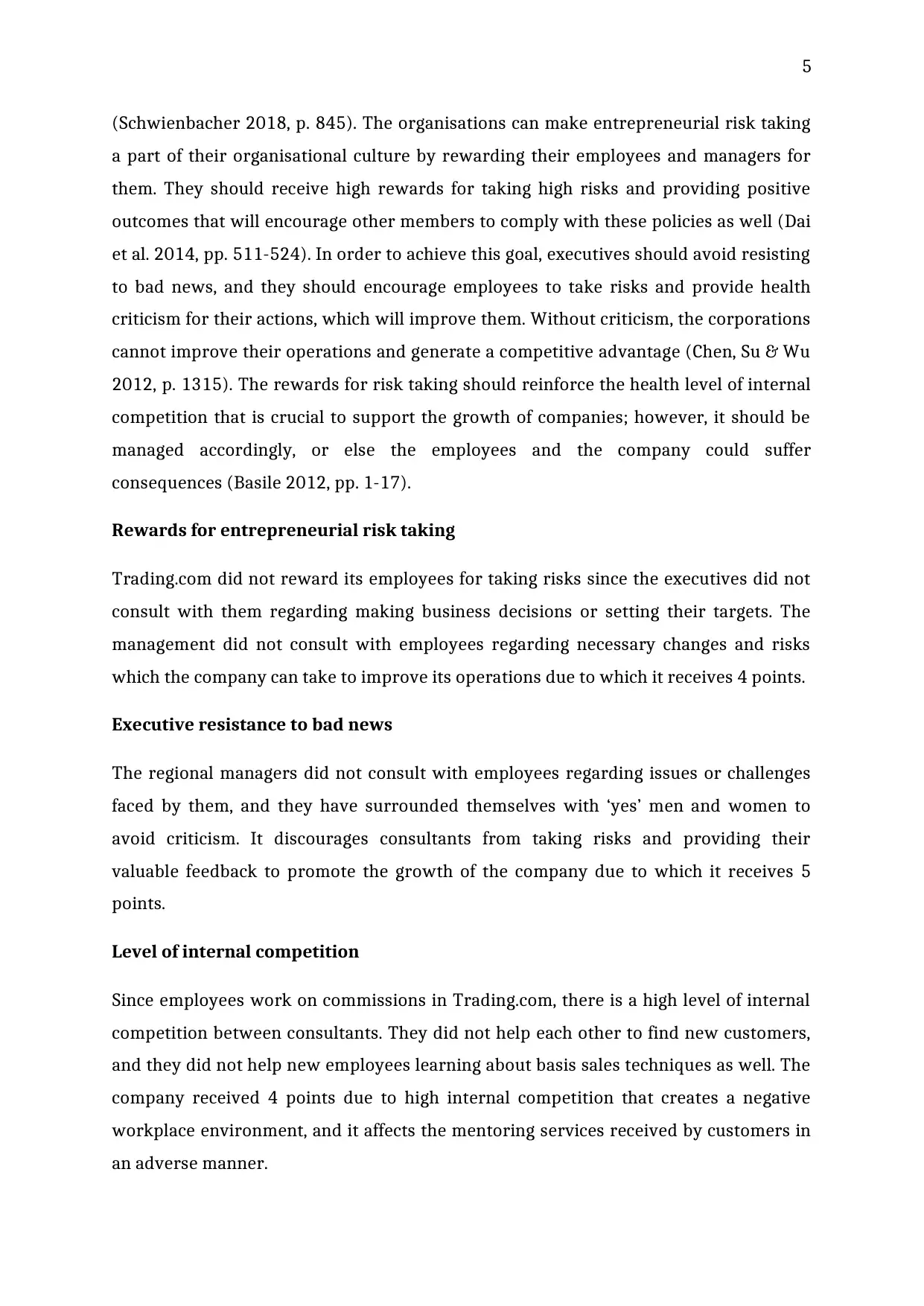
5
(Schwienbacher 2018, p. 845). The organisations can make entrepreneurial risk taking
a part of their organisational culture by rewarding their employees and managers for
them. They should receive high rewards for taking high risks and providing positive
outcomes that will encourage other members to comply with these policies as well (Dai
et al. 2014, pp. 511-524). In order to achieve this goal, executives should avoid resisting
to bad news, and they should encourage employees to take risks and provide health
criticism for their actions, which will improve them. Without criticism, the corporations
cannot improve their operations and generate a competitive advantage (Chen, Su & Wu
2012, p. 1315). The rewards for risk taking should reinforce the health level of internal
competition that is crucial to support the growth of companies; however, it should be
managed accordingly, or else the employees and the company could suffer
consequences (Basile 2012, pp. 1-17).
Rewards for entrepreneurial risk taking
Trading.com did not reward its employees for taking risks since the executives did not
consult with them regarding making business decisions or setting their targets. The
management did not consult with employees regarding necessary changes and risks
which the company can take to improve its operations due to which it receives 4 points.
Executive resistance to bad news
The regional managers did not consult with employees regarding issues or challenges
faced by them, and they have surrounded themselves with ‘yes’ men and women to
avoid criticism. It discourages consultants from taking risks and providing their
valuable feedback to promote the growth of the company due to which it receives 5
points.
Level of internal competition
Since employees work on commissions in Trading.com, there is a high level of internal
competition between consultants. They did not help each other to find new customers,
and they did not help new employees learning about basis sales techniques as well. The
company received 4 points due to high internal competition that creates a negative
workplace environment, and it affects the mentoring services received by customers in
an adverse manner.
(Schwienbacher 2018, p. 845). The organisations can make entrepreneurial risk taking
a part of their organisational culture by rewarding their employees and managers for
them. They should receive high rewards for taking high risks and providing positive
outcomes that will encourage other members to comply with these policies as well (Dai
et al. 2014, pp. 511-524). In order to achieve this goal, executives should avoid resisting
to bad news, and they should encourage employees to take risks and provide health
criticism for their actions, which will improve them. Without criticism, the corporations
cannot improve their operations and generate a competitive advantage (Chen, Su & Wu
2012, p. 1315). The rewards for risk taking should reinforce the health level of internal
competition that is crucial to support the growth of companies; however, it should be
managed accordingly, or else the employees and the company could suffer
consequences (Basile 2012, pp. 1-17).
Rewards for entrepreneurial risk taking
Trading.com did not reward its employees for taking risks since the executives did not
consult with them regarding making business decisions or setting their targets. The
management did not consult with employees regarding necessary changes and risks
which the company can take to improve its operations due to which it receives 4 points.
Executive resistance to bad news
The regional managers did not consult with employees regarding issues or challenges
faced by them, and they have surrounded themselves with ‘yes’ men and women to
avoid criticism. It discourages consultants from taking risks and providing their
valuable feedback to promote the growth of the company due to which it receives 5
points.
Level of internal competition
Since employees work on commissions in Trading.com, there is a high level of internal
competition between consultants. They did not help each other to find new customers,
and they did not help new employees learning about basis sales techniques as well. The
company received 4 points due to high internal competition that creates a negative
workplace environment, and it affects the mentoring services received by customers in
an adverse manner.
⊘ This is a preview!⊘
Do you want full access?
Subscribe today to unlock all pages.

Trusted by 1+ million students worldwide
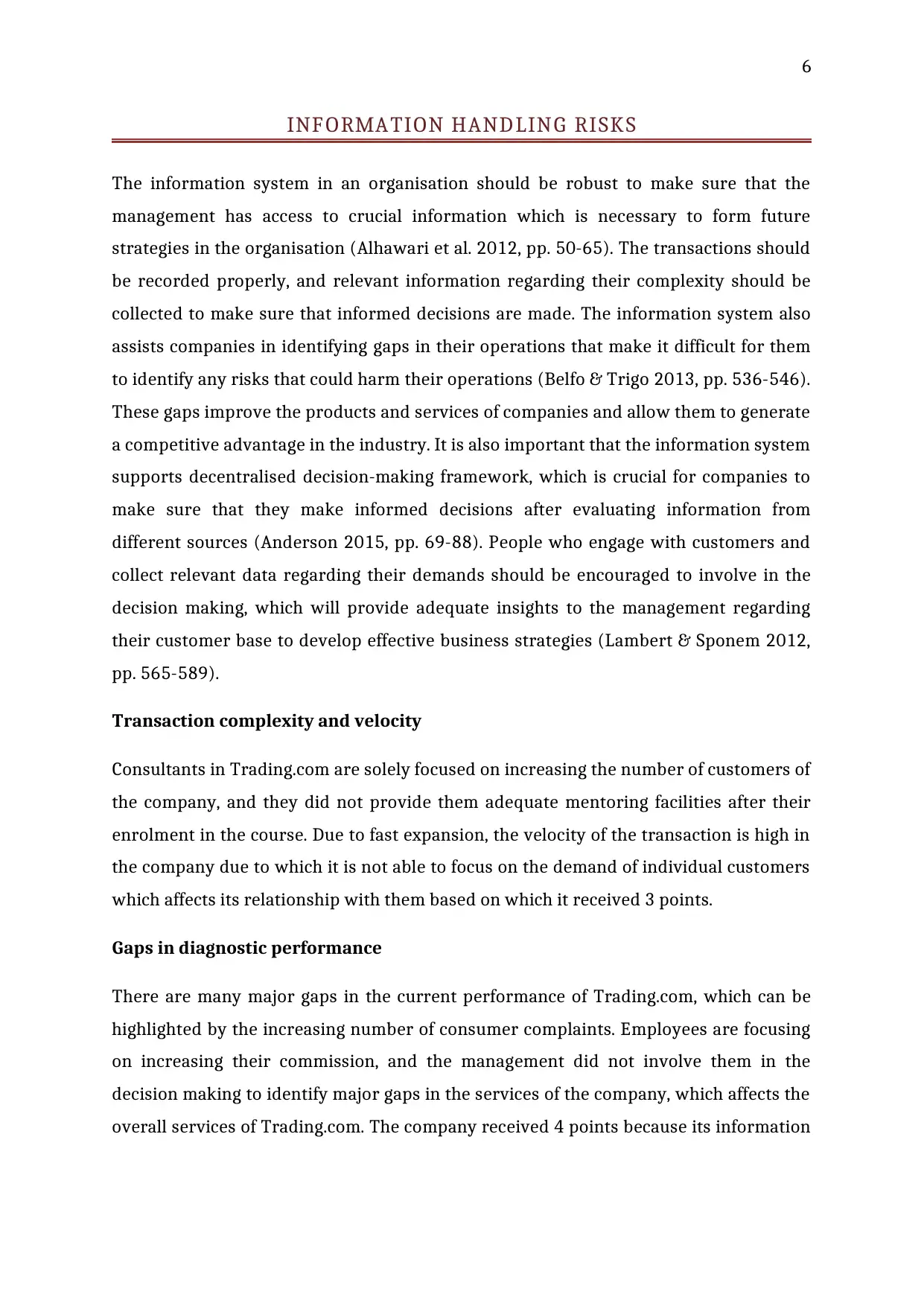
6
INFORMATION HANDLING RISKS
The information system in an organisation should be robust to make sure that the
management has access to crucial information which is necessary to form future
strategies in the organisation (Alhawari et al. 2012, pp. 50-65). The transactions should
be recorded properly, and relevant information regarding their complexity should be
collected to make sure that informed decisions are made. The information system also
assists companies in identifying gaps in their operations that make it difficult for them
to identify any risks that could harm their operations (Belfo & Trigo 2013, pp. 536-546).
These gaps improve the products and services of companies and allow them to generate
a competitive advantage in the industry. It is also important that the information system
supports decentralised decision-making framework, which is crucial for companies to
make sure that they make informed decisions after evaluating information from
different sources (Anderson 2015, pp. 69-88). People who engage with customers and
collect relevant data regarding their demands should be encouraged to involve in the
decision making, which will provide adequate insights to the management regarding
their customer base to develop effective business strategies (Lambert & Sponem 2012,
pp. 565-589).
Transaction complexity and velocity
Consultants in Trading.com are solely focused on increasing the number of customers of
the company, and they did not provide them adequate mentoring facilities after their
enrolment in the course. Due to fast expansion, the velocity of the transaction is high in
the company due to which it is not able to focus on the demand of individual customers
which affects its relationship with them based on which it received 3 points.
Gaps in diagnostic performance
There are many major gaps in the current performance of Trading.com, which can be
highlighted by the increasing number of consumer complaints. Employees are focusing
on increasing their commission, and the management did not involve them in the
decision making to identify major gaps in the services of the company, which affects the
overall services of Trading.com. The company received 4 points because its information
INFORMATION HANDLING RISKS
The information system in an organisation should be robust to make sure that the
management has access to crucial information which is necessary to form future
strategies in the organisation (Alhawari et al. 2012, pp. 50-65). The transactions should
be recorded properly, and relevant information regarding their complexity should be
collected to make sure that informed decisions are made. The information system also
assists companies in identifying gaps in their operations that make it difficult for them
to identify any risks that could harm their operations (Belfo & Trigo 2013, pp. 536-546).
These gaps improve the products and services of companies and allow them to generate
a competitive advantage in the industry. It is also important that the information system
supports decentralised decision-making framework, which is crucial for companies to
make sure that they make informed decisions after evaluating information from
different sources (Anderson 2015, pp. 69-88). People who engage with customers and
collect relevant data regarding their demands should be encouraged to involve in the
decision making, which will provide adequate insights to the management regarding
their customer base to develop effective business strategies (Lambert & Sponem 2012,
pp. 565-589).
Transaction complexity and velocity
Consultants in Trading.com are solely focused on increasing the number of customers of
the company, and they did not provide them adequate mentoring facilities after their
enrolment in the course. Due to fast expansion, the velocity of the transaction is high in
the company due to which it is not able to focus on the demand of individual customers
which affects its relationship with them based on which it received 3 points.
Gaps in diagnostic performance
There are many major gaps in the current performance of Trading.com, which can be
highlighted by the increasing number of consumer complaints. Employees are focusing
on increasing their commission, and the management did not involve them in the
decision making to identify major gaps in the services of the company, which affects the
overall services of Trading.com. The company received 4 points because its information
Paraphrase This Document
Need a fresh take? Get an instant paraphrase of this document with our AI Paraphraser
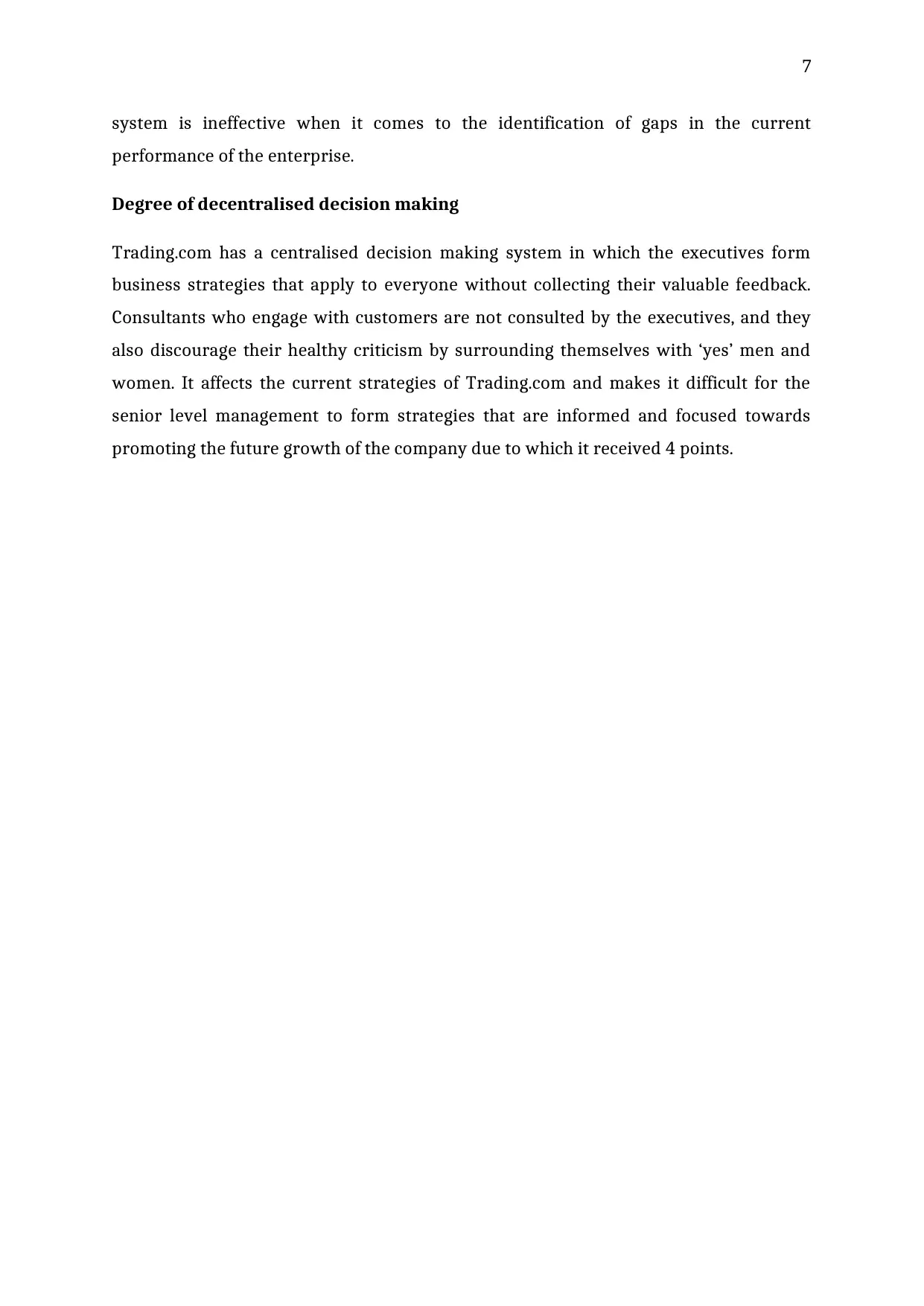
7
system is ineffective when it comes to the identification of gaps in the current
performance of the enterprise.
Degree of decentralised decision making
Trading.com has a centralised decision making system in which the executives form
business strategies that apply to everyone without collecting their valuable feedback.
Consultants who engage with customers are not consulted by the executives, and they
also discourage their healthy criticism by surrounding themselves with ‘yes’ men and
women. It affects the current strategies of Trading.com and makes it difficult for the
senior level management to form strategies that are informed and focused towards
promoting the future growth of the company due to which it received 4 points.
system is ineffective when it comes to the identification of gaps in the current
performance of the enterprise.
Degree of decentralised decision making
Trading.com has a centralised decision making system in which the executives form
business strategies that apply to everyone without collecting their valuable feedback.
Consultants who engage with customers are not consulted by the executives, and they
also discourage their healthy criticism by surrounding themselves with ‘yes’ men and
women. It affects the current strategies of Trading.com and makes it difficult for the
senior level management to form strategies that are informed and focused towards
promoting the future growth of the company due to which it received 4 points.
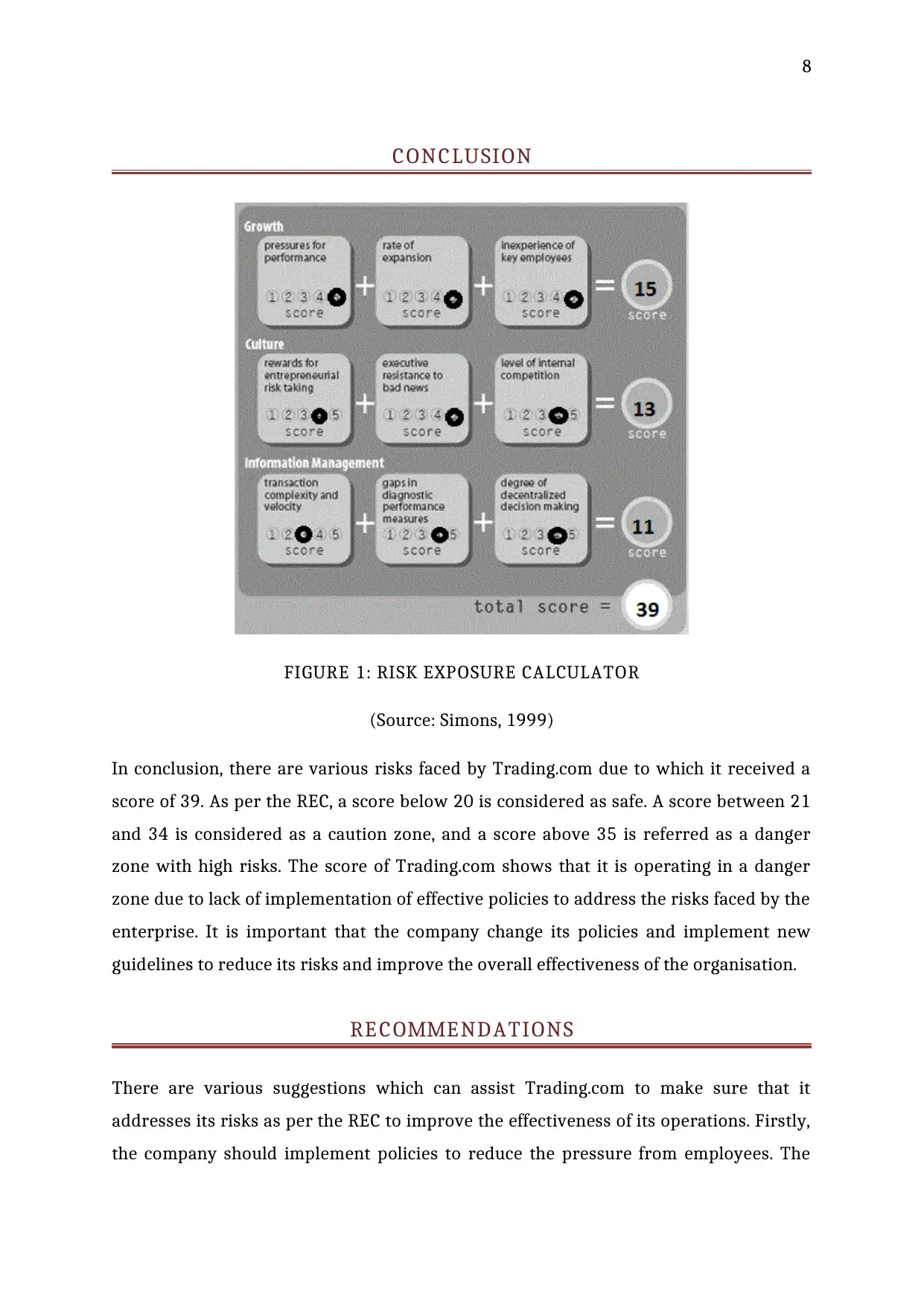
8
CONCLUSION
FIGURE 1: RISK EXPOSURE CALCULATOR
(Source: Simons, 1999)
In conclusion, there are various risks faced by Trading.com due to which it received a
score of 39. As per the REC, a score below 20 is considered as safe. A score between 21
and 34 is considered as a caution zone, and a score above 35 is referred as a danger
zone with high risks. The score of Trading.com shows that it is operating in a danger
zone due to lack of implementation of effective policies to address the risks faced by the
enterprise. It is important that the company change its policies and implement new
guidelines to reduce its risks and improve the overall effectiveness of the organisation.
RECOMMENDATIONS
There are various suggestions which can assist Trading.com to make sure that it
addresses its risks as per the REC to improve the effectiveness of its operations. Firstly,
the company should implement policies to reduce the pressure from employees. The
CONCLUSION
FIGURE 1: RISK EXPOSURE CALCULATOR
(Source: Simons, 1999)
In conclusion, there are various risks faced by Trading.com due to which it received a
score of 39. As per the REC, a score below 20 is considered as safe. A score between 21
and 34 is considered as a caution zone, and a score above 35 is referred as a danger
zone with high risks. The score of Trading.com shows that it is operating in a danger
zone due to lack of implementation of effective policies to address the risks faced by the
enterprise. It is important that the company change its policies and implement new
guidelines to reduce its risks and improve the overall effectiveness of the organisation.
RECOMMENDATIONS
There are various suggestions which can assist Trading.com to make sure that it
addresses its risks as per the REC to improve the effectiveness of its operations. Firstly,
the company should implement policies to reduce the pressure from employees. The
⊘ This is a preview!⊘
Do you want full access?
Subscribe today to unlock all pages.

Trusted by 1+ million students worldwide
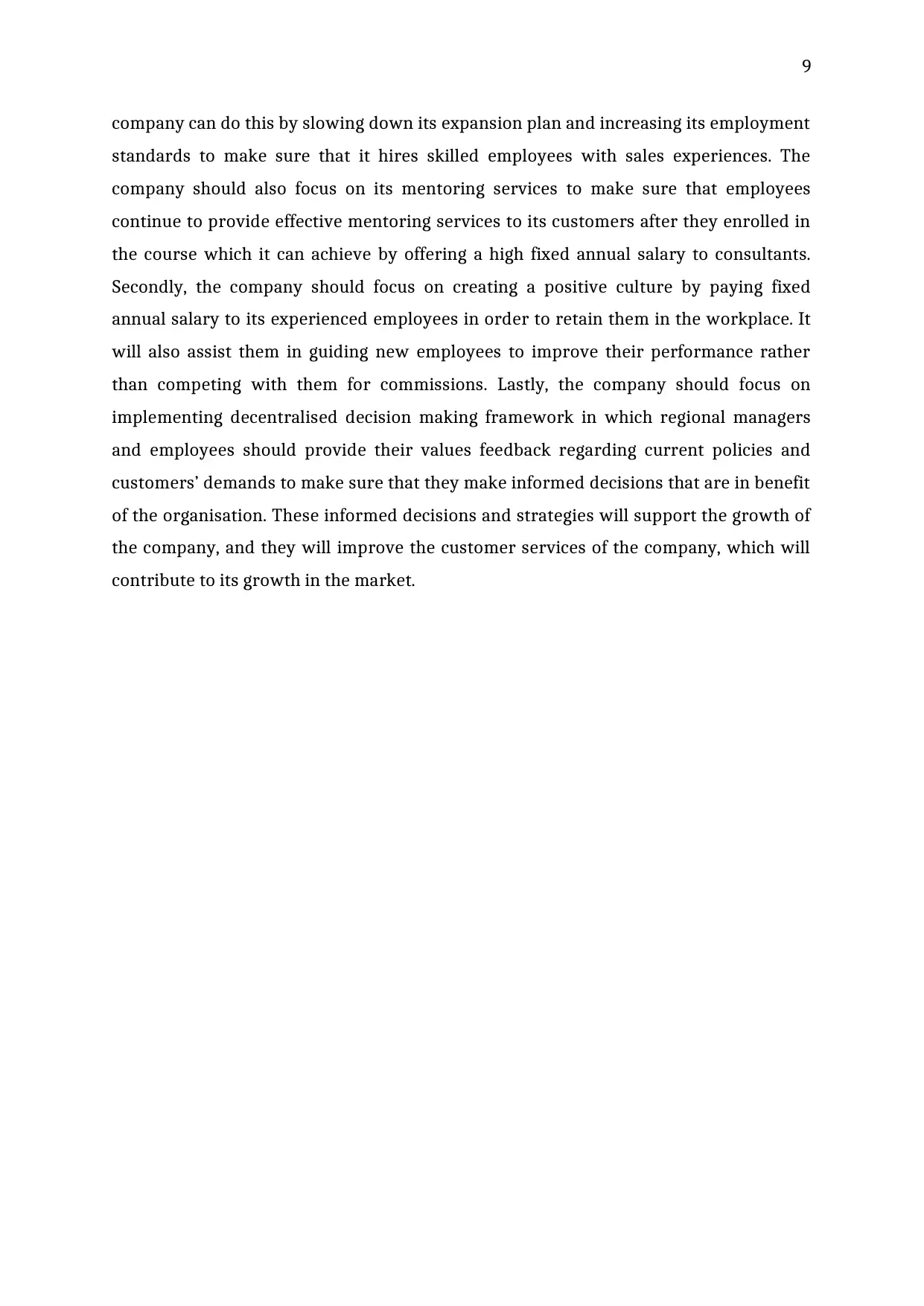
9
company can do this by slowing down its expansion plan and increasing its employment
standards to make sure that it hires skilled employees with sales experiences. The
company should also focus on its mentoring services to make sure that employees
continue to provide effective mentoring services to its customers after they enrolled in
the course which it can achieve by offering a high fixed annual salary to consultants.
Secondly, the company should focus on creating a positive culture by paying fixed
annual salary to its experienced employees in order to retain them in the workplace. It
will also assist them in guiding new employees to improve their performance rather
than competing with them for commissions. Lastly, the company should focus on
implementing decentralised decision making framework in which regional managers
and employees should provide their values feedback regarding current policies and
customers’ demands to make sure that they make informed decisions that are in benefit
of the organisation. These informed decisions and strategies will support the growth of
the company, and they will improve the customer services of the company, which will
contribute to its growth in the market.
company can do this by slowing down its expansion plan and increasing its employment
standards to make sure that it hires skilled employees with sales experiences. The
company should also focus on its mentoring services to make sure that employees
continue to provide effective mentoring services to its customers after they enrolled in
the course which it can achieve by offering a high fixed annual salary to consultants.
Secondly, the company should focus on creating a positive culture by paying fixed
annual salary to its experienced employees in order to retain them in the workplace. It
will also assist them in guiding new employees to improve their performance rather
than competing with them for commissions. Lastly, the company should focus on
implementing decentralised decision making framework in which regional managers
and employees should provide their values feedback regarding current policies and
customers’ demands to make sure that they make informed decisions that are in benefit
of the organisation. These informed decisions and strategies will support the growth of
the company, and they will improve the customer services of the company, which will
contribute to its growth in the market.
Paraphrase This Document
Need a fresh take? Get an instant paraphrase of this document with our AI Paraphraser

10
REFERENCES
Alhawari, S, Karadsheh, L, Talet, AN & Mansour, E 2012, ‘Knowledge-based risk
management framework for information technology project’, International Journal of
Information Management, vol. 32, no. 1, pp.50-65.
Andersen, TJ 2015, ‘Interactive strategy-making: Combining central reasoning with
ongoing learning from decentralised responses’, Journal of General Management, vol. 40,
no. 4, pp.69-88.
Basile, A 2012, ‘Entrepreneurial orientation in smes: risk-taking to entering
international markets’, Far East Journal of Psychology and Business, vol. 7, no. 2, pp.1-17.
Belfo, F & Trigo, A 2013, ‘Accounting information systems: Tradition and future
directions’, Procedia Technology, vol. 9, pp.536-546.
Chen, S, Su, X & Wu, S 2012, ‘Need for achievement, education, and entrepreneurial risk-
taking behavior’, Social Behavior and Personality: an international journal, vol. 40, no. 8,
pp.1311-1318.
Cheney, G, Santa Cruz, I, Peredo, AM & Nazareno, E 2014, ‘Worker cooperatives as an
organizational alternative: Challenges, achievements and promise in business
governance and ownership’, Organization, vol. 21, no. 5, pp.591-603.
Dai, L, Maksimov, V, Gilbert, BA & Fernhaber, SA 2014, ‘Entrepreneurial orientation and
international scope: The differential roles of innovativeness, proactiveness, and risk-
taking’, Journal of Business Venturing, vol. 29, no. 4, pp.511-524.
Ellen, M, Lippel, K, Ron, S, Agnieszka, K, Liz, M, Carrasco, C & Pugliese, D 2012, ‘Workers’
compensation experience-rating rules and the danger to workers’ safety in the
temporary work agency sector’, Policy and Practice in Health and Safety, vol. 10, no. 1,
pp.77-95.
Gelens, J, Hofmans, J, Dries, N & Pepermans, R 2014, ‘Talent management and
organisational justice: Employee reactions to high potential identification’, Human
Resource Management Journal, vol. 24, no. 2, pp.159-175.
REFERENCES
Alhawari, S, Karadsheh, L, Talet, AN & Mansour, E 2012, ‘Knowledge-based risk
management framework for information technology project’, International Journal of
Information Management, vol. 32, no. 1, pp.50-65.
Andersen, TJ 2015, ‘Interactive strategy-making: Combining central reasoning with
ongoing learning from decentralised responses’, Journal of General Management, vol. 40,
no. 4, pp.69-88.
Basile, A 2012, ‘Entrepreneurial orientation in smes: risk-taking to entering
international markets’, Far East Journal of Psychology and Business, vol. 7, no. 2, pp.1-17.
Belfo, F & Trigo, A 2013, ‘Accounting information systems: Tradition and future
directions’, Procedia Technology, vol. 9, pp.536-546.
Chen, S, Su, X & Wu, S 2012, ‘Need for achievement, education, and entrepreneurial risk-
taking behavior’, Social Behavior and Personality: an international journal, vol. 40, no. 8,
pp.1311-1318.
Cheney, G, Santa Cruz, I, Peredo, AM & Nazareno, E 2014, ‘Worker cooperatives as an
organizational alternative: Challenges, achievements and promise in business
governance and ownership’, Organization, vol. 21, no. 5, pp.591-603.
Dai, L, Maksimov, V, Gilbert, BA & Fernhaber, SA 2014, ‘Entrepreneurial orientation and
international scope: The differential roles of innovativeness, proactiveness, and risk-
taking’, Journal of Business Venturing, vol. 29, no. 4, pp.511-524.
Ellen, M, Lippel, K, Ron, S, Agnieszka, K, Liz, M, Carrasco, C & Pugliese, D 2012, ‘Workers’
compensation experience-rating rules and the danger to workers’ safety in the
temporary work agency sector’, Policy and Practice in Health and Safety, vol. 10, no. 1,
pp.77-95.
Gelens, J, Hofmans, J, Dries, N & Pepermans, R 2014, ‘Talent management and
organisational justice: Employee reactions to high potential identification’, Human
Resource Management Journal, vol. 24, no. 2, pp.159-175.

11
Gupta, M 2015, ‘A study on employees perception towards employee
engagement’, Globsyn Management Journal, vol. 9, no. 1, p.45.
Laforet, S 2016, ‘Effects of organisational culture on organisational innovation
performance in family firms’, Journal of Small Business and Enterprise Development, vol.
23, no. 2, pp.379-407.
Lambert, C & Sponem, S 2012, ‘Roles, authority and involvement of the management
accounting function: a multiple case-study perspective’, European Accounting
Review, vol. 21, no. 3, pp.565-589.
Schwienbacher, A 2018, ‘Entrepreneurial risk-taking in crowdfunding campaigns’, Small
Business Economics, vol. 51, no. 4, pp.843-859.
Simons, R 1999, How Risky Is Your Company?, HBR, viewed 16 May 2019, <
https://hbr.org/1999/05/how-risky-is-your-company>.
Syrek, CJ, Apostel, E & Antoni, CH 2013, ‘Stress in highly demanding IT jobs:
Transformational leadership moderates the impact of time pressure on exhaustion and
work–life balance’, Journal of Occupational Health Psychology, vol. 18, no. 3, p.252.
Gupta, M 2015, ‘A study on employees perception towards employee
engagement’, Globsyn Management Journal, vol. 9, no. 1, p.45.
Laforet, S 2016, ‘Effects of organisational culture on organisational innovation
performance in family firms’, Journal of Small Business and Enterprise Development, vol.
23, no. 2, pp.379-407.
Lambert, C & Sponem, S 2012, ‘Roles, authority and involvement of the management
accounting function: a multiple case-study perspective’, European Accounting
Review, vol. 21, no. 3, pp.565-589.
Schwienbacher, A 2018, ‘Entrepreneurial risk-taking in crowdfunding campaigns’, Small
Business Economics, vol. 51, no. 4, pp.843-859.
Simons, R 1999, How Risky Is Your Company?, HBR, viewed 16 May 2019, <
https://hbr.org/1999/05/how-risky-is-your-company>.
Syrek, CJ, Apostel, E & Antoni, CH 2013, ‘Stress in highly demanding IT jobs:
Transformational leadership moderates the impact of time pressure on exhaustion and
work–life balance’, Journal of Occupational Health Psychology, vol. 18, no. 3, p.252.
⊘ This is a preview!⊘
Do you want full access?
Subscribe today to unlock all pages.

Trusted by 1+ million students worldwide
1 out of 12
Related Documents
Your All-in-One AI-Powered Toolkit for Academic Success.
+13062052269
info@desklib.com
Available 24*7 on WhatsApp / Email
![[object Object]](/_next/static/media/star-bottom.7253800d.svg)
Unlock your academic potential
Copyright © 2020–2025 A2Z Services. All Rights Reserved. Developed and managed by ZUCOL.





